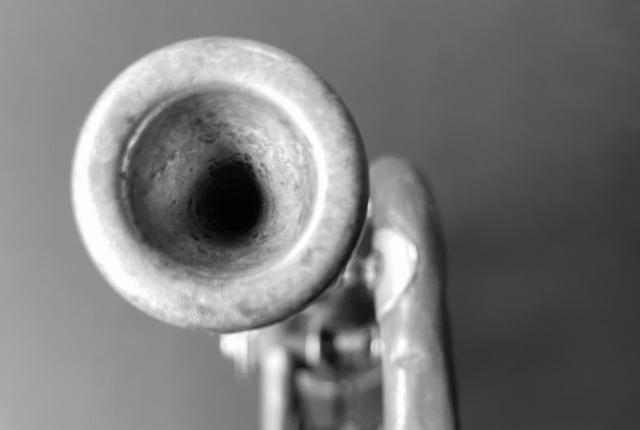Have you ever wondered how to make your trumpet quieter? You might know the awkward feeling of trying to get some practice done if you have sensitive neighbors or a spouse who doesn’t love your music nearly as much as you do. The good news is: There are ways to practice quietly, with or without your trumpet!
We’ll look at the Yamaha Silent Brass (a real trumpet silencer!), regular trumpet mutes and ways to practice your embouchure without making a sound.
How can you practice the trumpet quietly?
There are various methods to practice without the noise:
- Using the Yamaha Silent Brass on your trumpet with headphones
- Practicing your embouchure (without using your trumpet at all)
- Using a mute to dampen the sound of your horn
Use the Yamaha Silent Brass
The Yamaha Silent Brass* is a fascinating piece of technology that reduces the volume of your trumpet for everybody else, but lets you still hear it loud and clear. How does it work? By capturing the sound digitally as it’s blocking your bell. It’s essentially a trumpet mute with headphones that lets you silence your trumpet.
The Yamaha Silent Brass sounds even quieter than the Ssshhmute* and yet to your ears it will sound loud and clear. There’s a bit of back pressure, as with most mutes, but it’s a lot freer-blowing than some.
This “trumpet silencer with headphones” is excellent to practice with and you can even record your playing with it. There’s not a lot of setup with it either – it takes 2 AA batteries* (which are not included, unfortunately), other than that all the necessary cables are in the box.
You’ll want to make sure you get the newer version of this (SB7X), as the older version (ST9) had some issues, most notably the mute was easy to slip out and the pitch wasn’t very good. These issues are fixed in the newer version and it’s great fun to use.
To give you a short overview over the model numbers:
- SB7X-2 is the Silent Brass for trumpets
- SB6X-2 is the Flugelhorn version
- SB5X-2 is for trombones
- SB3X-2 fits the French horn
- SB2X is for the euphonium
- SB1X fits a tuba
- ST9 is the old version of the Silent Brass for trumpets
How To Record With The Yamaha Silent Brass
One convenient feature of the Yamaha Silent Brass is that you can record the sound that comes out of the gadget. See a detailed explanation about how that works here:
You’ll need:
- 3.5mm AUX cable*
- Audio recorder like the Zoom H1n* or the Zoom H4n*
- Headphones (e.g. Edifier headphones* as seen in the video, or if you can afford them, get some Audio-Technica ATH-M50s*)
There are other inventive ways of using the Silent Brass. One suggestion is to connect the device directly to an Ableton Live setup.
How to Play Along to Music with Yamaha Silent Brass
Another nifty feature of the Yamaha Silent Brass is that the gadget has an AUX IN jack that you can use to e.g. connect your phone to the device so you can play along to your favorite music. You’ll hear both the music and your own playing coming through your headphones.
This is a great way to make practicing fun. Get a book that comes with play-along music (like the Herb Alpert Jazz Play-Along book*) and play along to some great music without disturbing your neighbors.
Looking for a teacher?
Want to get lessons at the comfort of your own home? Check out the course Learn to Play the Trumpet: Beginner to Pro Made the Easy Way* on Udemy! (See their full trumpet course line-up here*!)
Use a trumpet mute
If you want something cheaper and lower tech than the Yamaha Silent Brass, there are a variety of mutes available to dampen the sound of your horn. You essentially stick these trumpet mufflers into the bell of your instrument and they will reduce the sound to a more tolerable level.
Pros
- Quieter than regular playing
Cons
- Muffled tones will sound a bit dull
- Some mutes require a bit of extra pressure to play
We recommend the sshhmute*, as it doesn’t need very much extra pressure to play and – along with the Silent Brass – it might be the quietest practice mute available. It gets the volume right down without hindering your playing too much. Plus, it’s a basic device that won’t break the bank.
Practice your embouchure
If you’re only looking for something to do if you have days off from playing or you’re going away for a few days without your trumpet, consider just practicing your embouchure with the Warburton P.E.T.E*.
It’s not a replacement for practicing your playing, of course, but it is a great tool to exercise your chops – and totally quiet at that. You can practice with it on a plane, in a hotel room late at night, or even while you’re watching TV.
Conclusion
There are several ways of playing the trumpet without the noise. If you want a low-tech version, get yourself a simple mute and reduce the decibels coming out of your instrument that way.
If you want a high-tech version, get the Yamaha Silent Brass to practice even more quietly while hearing yourself loud and clear through the headphones or jamming along to your favorite tracks.
If all you need is a simple way to do a bit of training without hauling around your instrument, get yourself an embouchure trainer to get your chops into shape.
Frequently Asked Questions
Why are trumpets so loud?
Trumpets are so loud simply because they were designed to be this way: They have a large flare that helps transmit the sound waves from the tube outwards. (For a more detailed explanation, see this Quora entry.)
How loud is a trumpet?
The volume of a trumpet can be in the range of 80 decibels to 120 decibels. For comparison, normal human conversation is at roughly 60 dB. Long exposure to anything over 70 dB can damage your hearing in the long run, so it’s important to protect your ears during your practice and performance.
What is the quietest practice mute?
The Yamaha Silent Brass system as well as the sshhmute (see above) are two of the most quiet trumpet mutes available. Another very quiet practice mute is the Warm-Up by Best Brass. The intonation is not perfect, but it reduces the volume considerably.
Related Posts:
- Practice Trumpet Without A Trumpet (7 Great Methods)
- Complete Guide to Trumpet Stands
- The Best Trumpet Cases (An Illustrated Guide)
- The 5 Worst Things When it Comes to Playing a Trumpet (and How to Avoid Them!)
- Top 3 Trumpet Maintenance Tips
TrumpetHub.com is a participant of the Amazon Services LLC Associates Program, an affiliate advertising program. Links marked with an asterisk (*) are affiliate links. If you buy a product through an affiliate link, we will get a small commission without extra cost to you. This helps us earn an income off the free content we provide to you. Thank you for your support!










